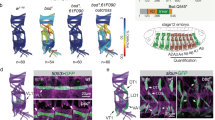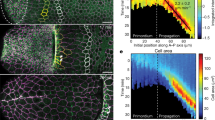Abstract
Rac GTPases regulate the actin cytoskeleton to control changes in cell shape1,2. To date, the analysis of Rac function during development has relied heavily on the use of dominant mutant isoforms. Here, we use loss-of-function mutations to show that the three Drosophila Rac genes, Rac1, Rac2 and Mtl, have overlapping functions in the control of epithelial morphogenesis, myoblast fusion, and axon growth and guidance. They are not required for the establishment of planar cell polarity, as had been suggested on the basis of studies using dominant mutant isoforms3,4. The guanine nucleotide exchange factor, Trio, is essential for Rac function in axon growth and guidance, but not for epithelial morphogenesis or myoblast fusion. Different Rac activators thus act in different developmental processes. The specific cellular response to Rac activation may be determined more by the upstream activator than the specific Rac protein involved.
This is a preview of subscription content, access via your institution
Access options
Subscribe to this journal
Receive 51 print issues and online access
$199.00 per year
only $3.90 per issue
Buy this article
- Purchase on Springer Link
- Instant access to full article PDF
Prices may be subject to local taxes which are calculated during checkout




Similar content being viewed by others
References
Hall, A. Rho GTPases and the actin cytoskeleton. Science 279, 509–514 (1998).
Luo, L. Rho GTPases in neuronal morphogenesis. Nature Rev. Neurosci. 1, 173–180 (2000).
Eaton, S., Wepf, R. & Simons, K. Roles for Rac1 and Cdc42 in planar polarization and hair outgrowth in the wing of Drosophila. J. Cell Biol. 135, 1277–1289 (1996).
Fanto, M., Weber, U., Strutt, D. I. & Mlodzik, M. Nuclear signaling by Rac and Rho GTPases is required in the establishment of epithelial planar polarity in the Drosophila eye. Curr. Biol. 10, 979–988 (2000).
Harden, N., Loh, H. Y., Chia, W. & Lim, L. A dominant inhibitory version of the small GTP-binding protein Rac disrupts cytoskeletal structures and inhibits developmental cell shape changes in Drosophila. Development 121, 903–914 (1995).
Luo, L., Liao, Y. J., Jan, L. Y. & Jan, Y. N. Distinct morphogenetic functions of similar small GTPases: Drosophila Drac1 is involved in axonal outgrowth and myoblast fusion. Genes Dev. 8, 1787–1802 (1994).
Kaufmann, N., Wills, Z. P. & Van Vactor, D. Drosophila Rac1 controls motor axon guidance. Development 125, 453–461 (1998).
Hariharan, I. K. et al. Characterization of Rho GTPase family homologues in Drosophila melanogaster: overexpressing Rho1 in retinal cells causes a late developmental defect. EMBO J. 14, 292–302 (1995).
Adams, M. D. et al. The genome sequence of Drosophila melanogaster. Science 287, 2185–2195 (2000).
Newsome, T. P. et al. Trio combines with Dock to regulate Pak activity during photoreceptor axon pathfinding in Drosophila. Cell 101, 283–294 (2000).
Ng, J. et al. Rac GTPases control axon growth, guidance and branching. Nature 416, 442–447 (2002).
Williams-Masson, E. M., Malik, A. N. & Hardin, J. An actin-mediated two-step mechanism is required for ventral enclosure of the C. elegans hypodermis. Development 124, 2889–2901 (1997).
Jacinto, A., Martinez-Arias, A. & Martin, P. Mechanisms of epithelial fusion and repair. Nature Cell Biol. 3, E117–E123 (2001).
Young, P. E., Richman, A. M., Ketchum, A. S. & Kiehart, D. P. Morphogenesis in Drosophila requires nonmuscle myosin heavy chain function. Genes Dev. 7, 29–41 (1993).
Edwards, K. A., Demsky, M., Montague, R. A., Weymouth, N. & Kiehart, D. P. GFP-moesin illuminates actin cytoskeleton dynamics in living tissue and demonstrates cell shape changes during morphogenesis in Drosophila. Dev. Biol. 191, 103–117 (1997).
Jacinto, A. et al. Dynamic actin-based epithelial adhesion and cell matching during Drosophila dorsal closure. Curr. Biol. 10, 1420–1426 (2000).
Wakelam, M. J. The fusion of myoblasts. Biochem. J. 228, 1–12 (1985).
Doberstein, S. K., Fetter, R. D., Mehta, A. Y. & Goodman, C. S. Genetic analysis of myoblast fusion: blown fuse is required for progression beyond the prefusion complex. J. Cell Biol. 136, 1249–1261 (1997).
Shulman, J. M., Perrimon, N. & Axelrod, J. D. Frizzled signaling and the developmental control of cell polarity. Trends Genet. 14, 452–458 (1998).
Newsome, T. P., Asling, B. & Dickson, B. J. Analysis of Drosophila photoreceptor axon guidance in eye-specific mosaics. Development 127, 851–860 (2000).
Awasaki, T. et al. The Drosophila trio plays an essential role in patterning of axons by regulating their directional extension. Neuron 26, 119–131 (2000).
Bateman, J., Shu, H. & Van Vactor, D. The guanine nucleotide exchange factor trio mediates axonal development in the Drosophila embryo. Neuron 26, 93–106 (2000).
Liebl, E. C. et al. Dosage-sensitive, reciprocal genetic interactions between the Abl tyrosine kinase and the putative GEF trio reveal trio's role in axon pathfinding. Neuron 26, 107–118 (2000).
Sone, M. et al. Still life, a protein in synaptic terminals of Drosophila homologous to GDP-GTP exchangers. Science 275, 543–547 (1997).
Reddien, P. W. & Horvitz, H. R. CED-2/CrkII and CED-10/Rac control phagocytosis and cell migration in Caenorhabditis elegans. Naure Cell Biol. 2, 131–136 (2000).
Lundquist, E. A., Reddien, P. W., Hartwieg, E., Horvitz, H. R. & Bargmann, C. I. Three C. elegans Rac proteins and several alternative Rac regulators control axon guidance, cell migration and apoptotic cell phagocytosis. Development 128, 4475–4488 (2001).
Chou, T. B., Noll, E. & Perrimon, N. Autosomal P[ovoD1] dominant female-sterile insertions in Drosophila and their use in generating germ-line chimeras. Development 119, 1359–1369 (1993).
Rajagopalan, S., Vivancos, V., Nicolas, E. & Dickson, B. J. Selecting a longitudinal pathway: Robo receptors specify the lateral position of axons in the Drosophila CNS. Cell 103, 1033–1045 (2000).
Winter, C. G. et al. Drosophila Rho-associated kinase (Drok) links Frizzled-mediated planar cell polarity signaling to the actin cytoskeleton. Cell 105, 81–91 (2001).
Chang, H. Y. & Ready, D. F. Rescue of photoreceptor degeneration in rhodopsin-null Drosophila mutants by activated Rac1. Science 290, 1978–1980 (2000).
Acknowledgements
We thank H. Halbritter for scanning electron microscopy; P. Rørth for generating and providing the EP0855 line; T. Newsome for the initial characterization of trio mutant embryos; and J. Knoblich, K. Nasmyth and members of the Dickson laboratory for comments on the manuscript. This research was supported by funding from Boehringer Ingelheim GmbH (B.J.D.), and grants from the National Institutes of Health (L.L.) and the Human Frontiers of Science Program (B.J.D. and L.L.).
Author information
Authors and Affiliations
Corresponding author
Ethics declarations
Competing interests
The authors declare that they have no competing financial interests
Rights and permissions
About this article
Cite this article
Hakeda-Suzuki, S., Ng, J., Tzu, J. et al. Rac function and regulation during Drosophila development. Nature 416, 438–442 (2002). https://doi.org/10.1038/416438a
Received:
Accepted:
Issue Date:
DOI: https://doi.org/10.1038/416438a
This article is cited by
-
Biasing the conformation of ELMO2 reveals that myoblast fusion can be exploited to improve muscle regeneration
Nature Communications (2022)
-
Filopodia-based contact stimulation of cell migration drives tissue morphogenesis
Nature Communications (2021)
-
An insight on Drosophila myogenesis and its assessment techniques
Molecular Biology Reports (2020)
-
Exocytosis-coordinated mechanisms for tip growth underlie pollen tube growth guidance
Nature Communications (2017)
-
Rac1 plays an essential role in axon growth and guidance and in neuronal survival in the central and peripheral nervous systems
Neural Development (2015)
Comments
By submitting a comment you agree to abide by our Terms and Community Guidelines. If you find something abusive or that does not comply with our terms or guidelines please flag it as inappropriate.



